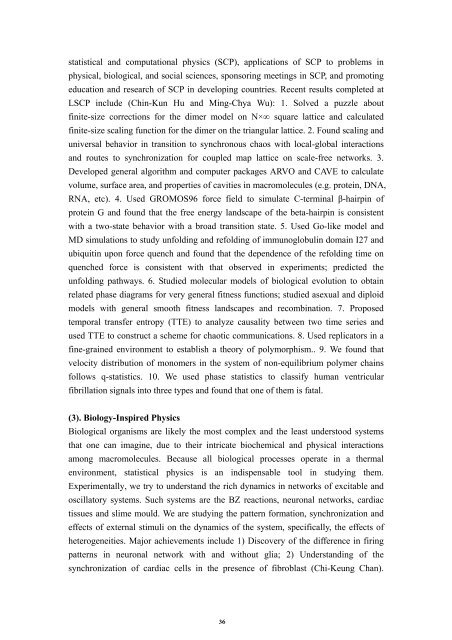2009 Annual Report Vol.37 - 中研院物理研究所 - Academia Sinica
2009 Annual Report Vol.37 - 中研院物理研究所 - Academia Sinica
2009 Annual Report Vol.37 - 中研院物理研究所 - Academia Sinica
Create successful ePaper yourself
Turn your PDF publications into a flip-book with our unique Google optimized e-Paper software.
statistical and computational physics (SCP), applications of SCP to problems in<br />
physical, biological, and social sciences, sponsoring meetings in SCP, and promoting<br />
education and research of SCP in developing countries. Recent results completed at<br />
LSCP include (Chin-Kun Hu and Ming-Chya Wu): 1. Solved a puzzle about<br />
finite-size corrections for the dimer model on N×∞ square lattice and calculated<br />
finite-size scaling function for the dimer on the triangular lattice. 2. Found scaling and<br />
universal behavior in transition to synchronous chaos with local-global interactions<br />
and routes to synchronization for coupled map lattice on scale-free networks. 3.<br />
Developed general algorithm and computer packages ARVO and CAVE to calculate<br />
volume, surface area, and properties of cavities in macromolecules (e.g. protein, DNA,<br />
RNA, etc). 4. Used GROMOS96 force field to simulate C-terminal β-hairpin of<br />
protein G and found that the free energy landscape of the beta-hairpin is consistent<br />
with a two-state behavior with a broad transition state. 5. Used Go-like model and<br />
MD simulations to study unfolding and refolding of immunoglobulin domain I27 and<br />
ubiquitin upon force quench and found that the dependence of the refolding time on<br />
quenched force is consistent with that observed in experiments; predicted the<br />
unfolding pathways. 6. Studied molecular models of biological evolution to obtain<br />
related phase diagrams for very general fitness functions; studied asexual and diploid<br />
models with general smooth fitness landscapes and recombination. 7. Proposed<br />
temporal transfer entropy (TTE) to analyze causality between two time series and<br />
used TTE to construct a scheme for chaotic communications. 8. Used replicators in a<br />
fine-grained environment to establish a theory of polymorphism.. 9. We found that<br />
velocity distribution of monomers in the system of non-equilibrium polymer chains<br />
follows q-statistics. 10. We used phase statistics to classify human ventricular<br />
fibrillation signals into three types and found that one of them is fatal.<br />
(3). Biology-Inspired Physics<br />
Biological organisms are likely the most complex and the least understood systems<br />
that one can imagine, due to their intricate biochemical and physical interactions<br />
among macromolecules. Because all biological processes operate in a thermal<br />
environment, statistical physics is an indispensable tool in studying them.<br />
Experimentally, we try to understand the rich dynamics in networks of excitable and<br />
oscillatory systems. Such systems are the BZ reactions, neuronal networks, cardiac<br />
tissues and slime mould. We are studying the pattern formation, synchronization and<br />
effects of external stimuli on the dynamics of the system, specifically, the effects of<br />
heterogeneities. Major achievements include 1) Discovery of the difference in firing<br />
patterns in neuronal network with and without glia; 2) Understanding of the<br />
synchronization of cardiac cells in the presence of fibroblast (Chi-Keung Chan).<br />
36

















